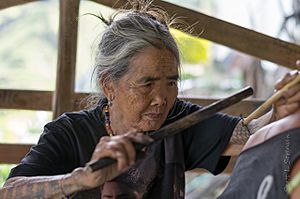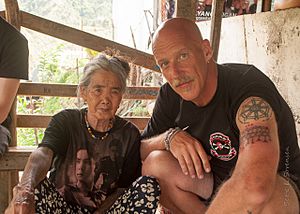Whang-od facts for kids
Quick facts for kids
Whang-od
|
|
|---|---|

Whang-od tattooing on June 30, 2016
|
|
| Born |
Whang-od Oggay
February 17, 1917 Tinglayan, Kalinga, Mountain Province, Philippine Islands
|
| Nationality | Filipino |
| Other names |
|
| Known for | Last and oldest practitioner of Kalinga tattooing Oldest person on the cover of Vogue |
| Awards | Presidential Medal of Merit (Philippines) |
Whang-od Oggay (pronounced `(h)wang-od`), also known as Maria Oggay, is a famous tattoo artist from the village of Buscalan in Tinglayan, Kalinga, Philippines. She is often called the "last" and oldest mambabatok. A mambabatok is a traditional Kalinga tattoo artist. She belongs to the Butbut people, who are part of the larger Kalinga ethnic group.
Whang-od started tattooing when she was about 11 years old. She tattooed Butbut warriors and women. Warriors traditionally earned tattoos for their bravery in battles. Today, tribal warfare has ended in the region. Whang-od now tattoos tourists who visit her village.
She speaks her native language, Kalinga, and Ilocano. Ilocano is a common language in Northern Luzon. She does not speak Filipino or English.
In April 2023, Whang-od, who was 106 years old at the time, appeared on the cover of Vogue Philippines. This made her the oldest person ever to be on the cover of Vogue.
In 2018, the National Commission for Culture and the Arts (NCCA) gave Whang-od the important Dangal ng Haraya Award. This award was given in Tabuk, the capital of Kalinga province. She was also nominated for the National Living Treasures Award in 2017. This award honors Filipino artists who keep traditional arts alive.
Contents
Biography
How Whang-od Became a Tattoo Artist
Whang-od began tattooing at age 15. She learned this ancient art from her father. He was a master tattooist in their area. Traditionally, only men from certain families could learn tattooing. But Whang-od was special because her father saw her great talent.
Later, Whang-od chose only women to be her apprentices. This was the first time in Kalinga history that women were chosen to carry on this tradition. Her community accepted her decision. She used to do batok, which is traditional hand-tapped tattooing, on male warriors. These warriors earned tattoos for protecting their villages or defeating enemies. She also tattooed women of the Butbut people for beauty.
The Art of Batok Tattooing
As a traditional Kalinga tattooist, Whang-od used to tell fortunes and chant while tattooing. Each design she created had special meanings in the mambabatok culture. For example, a warrior who had won a battle would get an eagle tattoo.
Whang-od herself received her first tattoos as a teenager. These designs included a ladder and a python. The python tattoo was very important in her people's sacred stories. It was believed to be a gift from a hero-god named Banna to a noblewoman named Lagkunawa. This tattoo was then passed down through generations.
Fatok is the name for tattoos given to women to show their beauty and wealth. If a woman's arm was tattooed like Whang-od's, her family would pay the tattoo artist with a piglet or a bundle of rice. Fi-ing was the term for tattoos on male Butbut warriors' chests and arms. Whang-od used to do fi-ing until the government stopped headhunting in 1972.
Tattooing Today
Even though headhunting no longer happens, Whang-od still tattoos visitors to Buscalan. However, she no longer chants when tattooing tourists. The chants are only for making Kalinga women beautiful or celebrating Kalinga men's victories. Many people, including some famous ones, have visited her for tattoos.
In the past, her tattoos did not earn her money. But with many tourists visiting, she earned a good amount each day in 2015. She often tattoos twenty to thirty customers daily. Because of her age, she now mostly does simpler tattoos. Her apprentices, all women, continue the more complex work.
The tattoo ink she uses is made from natural materials. It is usually a mix of charcoal and water. This ink is tapped into the skin using a thorn from a calamansi or pomelo tree. This ancient batok technique is thousands of years old. It can be more painful than modern tattooing. Her designs come from nature and basic shapes. Since 2017, her special signature tattoo is three dots. These dots represent herself and her two main apprentices. They show how the art is passed from older to younger generations.
Besides tattooing, Whang-od is a respected elder in her village. She also plays the nose flute. She helps with farm tasks like feeding animals and growing rice.
Whang-od's Personal Life
When she was young, Whang-od had a boyfriend named Ang-Batang. He was a Butbut warrior. She tattooed him after his first battle victory. However, their relationship was not approved by some elders. Ang-Batang later died in an accident when Whang-od was 25.
Whang-od decided never to marry and has no children. This means she has no direct descendants to continue her tattooing art. According to tradition, tattooing skills can only be passed down through family members. Whang-od believes that if someone outside the family line tattoos, the tattoos might get infected.
For many years, young people in her village were not interested in learning the old tattooing ways. But in the 21st century, there was a new interest in Indigenous cultures. This helped save the art form in Buscalan. Whang-od has trained her grandniece, Grace Palicas, and another relative, Ilyang Wigan. More relatives, like 12-year-old Den Wigan, have also become interested.
However, these younger artists do not perform all parts of a mambabatok's work. They do not do the chanting or fortune-telling. These parts of the tradition are only for the Kalinga people. This means that these special parts of the batok tradition might disappear with Whang-od. She might be the last mambabatok of her village unless her apprentices learn these difficult chanting arts.
Whang-od's Impact on Culture
Senator Nancy Binay has said that Whang-od has helped people learn about Kalinga tattoos. She has kept this knowledge and tradition alive for younger generations and people outside the Philippines. The practice of Kalinga tattoos was almost lost.
Whang-od is teaching many young girls, including her grandnieces, the art of mambabatok. This ensures the tradition will continue. Out of her students, Grace Palicas and Ilyang Wigan are considered her main apprentices. This is because, by tradition, the art must be taught to blood relatives. Whang-od's "signature" tattoo of three dots represents herself and her blood-related apprentices. It shows the art moving to the next generation.
Her Age and Recognition
Many sources say Whang-od was born on February 17, 1917. This would mean she turned 100 in 2017. If so, she could receive benefits from the Philippine government. However, there were no birth records in many remote areas like Buscalan when she was born. In June 2017, she received a postal ID that officially recognized her birth date as February 17, 1917. This made her eligible for government benefits.
Awards and Honors
Many people have asked for Whang-od to be recognized as a National Artist of the Philippines. This is a high honor for Filipino artists. A social media campaign using the hashtag #WangOdNationalArtist started in 2015. Some people also wanted her to receive the National Living Treasures Award.
In 2015, Senator Miriam Defensor Santiago suggested that Whang-od should be nominated for the National Living Treasures Award. This award is equal in rank to the National Artist award. Other senators, like Nancy Binay and Loren Legarda, also supported her nomination.
Former NCCA chairman Felipe de Leon Jr. also supported Whang-od. He said that a mambabatok helps bring the community together. He also noted that she helps her community by tattooing tourists. This shows she practices traditional Kalinga art as a way of life.
Whang-od was officially nominated for the National Living Treasures Award on October 21, 2017. The NCCA accepted her nomination. If she receives the award, she would get a gold medal, a monthly allowance, and a starting grant. On February 28, 2018, the Philippine Senate supported her nomination.
On June 12, 2018, the NCCA announced that Whang-od would receive the Dangal ng Haraya Award. This award was given on June 25 in Tabuk, Kalinga. On February 14, 2024, Whang-od received the Presidential Medal of Merit from President Bongbong Marcos.
On May 1, 2024, Michelle Dee, a beauty queen, got a tattoo from Whang-od. Whang-od tattooed her signature three dots on Dee's arm. Dee then playfully "crowned" Whang-od as a "beauty queen."
Media Features
American anthropologist Lars Krutak visited Kalinga in 2007. He documented Whang-od's tattoo work. An episode of Krutak's series Tattoo Hunter on Discovery Channel showed the Kalinga culture and Whang-od to a global audience. In 2010, she was also featured in i-Witness, a documentary on GMA Network.
In 2017, Whang-od was featured in the Dayaw series by the NCCA and ABS-CBN News Channel. This series showed her importance to the country's culture. Her life story was also shown in Wagas, a drama series on GMA News TV in 2017.
Important Note: Whang-od Academy
In 2021, a YouTuber named Nas Daily created something called "Whang-od Academy" on his platform. This was done without Whang-od's full permission. The National Commission on Indigenous Peoples (NCIP) looked into the issue. Whang-od's grandniece spoke out against it. Nas Daily responded, but faced criticism. As a result, the academy was stopped.
See also
 In Spanish: Whang-od para niños
In Spanish: Whang-od para niños
- Philippine tattoos
- Visayan tattoos
- Kalinga (province)



